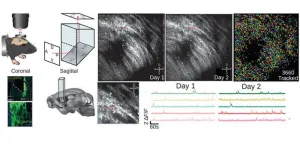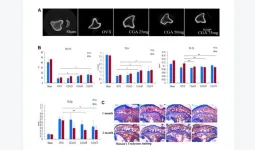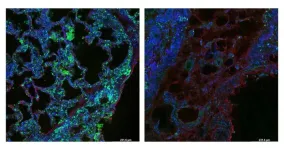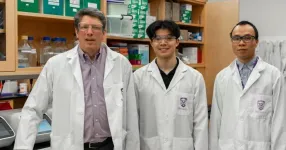(Press-News.org) The ORIGAMI (Optimized Resource Integration and Global Architecture for Mobile Infrastructure for 6G) project is now underway. The project, funded by the European Commission under the Horizon Europe program, will spearhead architectural innovations for the next generation of 6G mobile networks, to enable innovative applications, new business models, and substantial reductions in energy consumption.
By proposing and developing three critical architecture innovations – Global Services Based Architecture (GSBA), Zero Trust Exposure Layer (ZTL), and Continuous Compute Layer (CCL) -, ORIGAMI will create unique global standards, promote green transition, give new impetus to accessibility and inspire innovative applications and new business models, maximizing the exploitation of AI-based Network Intelligence functions. The project will conduct eight real-world demonstrations at six experimental sites and two large-scale international datasets from two major operators, which will validate its technology and research results.
“The environment proposed by ORIGAMI will streamline communication and interoperability at all levels of the network, pave the way for truly global standards, democratize access to extremely heterogeneous computing resources, and allow third parties to securely program their virtual networks in zero-trust environments”, says Dr. Javier García Rodrigo, Project Coordinator at Telefónica Digital Innovation. “This research – Dr. García Rodrigo continues – is probably the first in Europe to holistically address substantial barriers to the success of 6G, from limitations in the control and interoperability of virtualized infrastructure, to the lack of adequate support for global operations and billing, which are increasingly common in real-world scenarios”.
The project extends the scope of previous works such as DAEMON, led by IMDEA Networks Institute and based on the 5G architectural model, intending to increase the full potential of virtualization and programmability. To achieve this objective, ORIGAMI will adopt a completely renewed perspective: proposing a novel cross-plane architecture for 6G networks that supports original exposure and computation layers. A framework of functionalities within which actions such as supporting the global operation model of vertical applications, mass IoT deployment, or maximizing the potential of virtualization and programmability stand out.
Marco Fiore, Principal Investigator of IMDEA Networks Institute in the project, highlights the institution’s contribution to this scientific performance: “We bring our expertise in AI-based network function design and network user plane programmability. Specifically, we will work to develop and demonstrate in industrial-level experimental testbeds new machine learning models that can operate on heterogeneous user planes through efficient model design and hardware allocations. This approach will enable more agile access to the capabilities of modern programmable transport domains. For network operators, our solutions will translate into increased speed, accuracy, and scalability compared to the current state of the art.”
An example of technology transfer to society
Current overall energy use by the telecommunications industry must be reduced, as the industry consumes 2-3% of the world’s energy. ORIGAMI will develop solutions that enable energy-wise RAN operations, including 2 times more efficient energy use and a 35% reduction in energy consumption.
Another objective is to help bridge the gap between rural and urban connectivity to build more efficient mobile networks, (aiming for a 10x improvement in RAN cost efficiency, or savings of the order of 50% in CAPEX to support global operations).
In addition, as ORIGAMI will contribute to developing more efficient and better performing mobile networks, with lower latency, higher throughput, and higher reliability, many public sectors and people’s daily activities will be significantly improved, as life today is totally dependent on the widespread use of mobile networks.
ORIGAMI will help deliver better services beyond mobile networks. With the advent of 5G and new paradigms such as network slicing, mobile networks can provide customized services to different vertical industries. In this way, many services critical to society can be digitized and substantially enhanced, including education, healthcare, transportation, etc.
END
ORIGAMI: anticipating the future of more connected, efficient and sustainable telecommunication infrastructures
The project will contribute to the development of mobile networks with lower latency, higher throughput and higher reliability, which will significantly improve the daily activities of many public sectors and citizens
2024-03-26
ELSE PRESS RELEASES FROM THIS DATE:
Study says it’s time to highlight positive skills associated with neurodevelopmental conditions
2024-03-26
New research says the wide variety of skills displayed by people with conditions such as ADHD, dyslexia and autism should be celebrated to help reduce stigma and change society’s expectations.
Creativity, resilience and problem-solving are just some of the strengths exhibited and a study is now calling for a change in the way we think about people with neurodevelopmental conditions.
Dr Edwin Burns, senior lecturer from the School of Psychology at Swansea University, worked with academics from Edge Hill University on the study and their findings have just been published by ...
Corporations use government grants to lighten debt load
2024-03-26
Local and state governments have a variety of tools at their disposal to attract businesses or entice them to stay. One is tax relief. Austin, for example, helped lure electric automaker Tesla in part with property tax rebates worth $14 million over 10 years.
In a study released today from Texas McCombs, Dean and Accounting Professor Lillian Mills finds that another kind of government aid — cash grants — has a different kind of impact. It helps companies lighten their balance sheets by borrowing less.
Corporations ...
C-Path launches consortium for alpha-1 antitrypsin deficiency
2024-03-26
TUCSON, Ariz., March 26, 2024 — Critical Path Institute (C-Path) is excited to announce the launch of the Critical Path for Alpha-1 Antitrypsin Deficiency (CPA-1) Consortium. The CPA-1 consortium aims to accelerate drug development for alpha-1 antitrypsin deficiency (AATD), a rare disease that affects individuals and families worldwide. This will be achieved by integrating data through C-Path’s Rare Diseases Cures Accelerator–Data Analytics Platform (RDCA-DAP®) and leveraging those data for CPA-1 to collaboratively develop regulatory-grade solutions to continuously address unmet needs in drug development for this condition, including:
Generating evidence to ...
In paleontology, correct names are keys to accurate study
2024-03-26
COLUMBUS, Ohio – When the skeletal remains of a giant ground sloth were first unearthed in 1796, the discovery marked one of the earliest paleontological finds in American history.
The animal, named Megalonyx by Thomas Jefferson in 1799, was the first genus of fossil named from the United States. Thought to have roamed North America during one of the last ice ages, the extinct giant ground sloth was an herbivorous mammal resembling a large bear — at full size, it likely reached nearly 10 feet tall (3 meters) and weighed about as much as a small elephant.
The report made by Jefferson, an avid fossil collector who was known to keep ...
Imaging deep brain activity with microprisms
2024-03-26
Organisms constantly face the challenge of adapting their behavior to survive in a world full of uncertainties. This ability relies on complex neural circuits in the brain that help them find resources while avoiding danger. Scientists study how these neural circuits change over time to understand better how behaviors emerge.
One powerful way to study these changes is through optical imaging techniques that allow researchers to track the activity of individual brain cells. Traditional methods rely on observing the activity of cells directly, ...
Chlorogenic acid prevents ovariectomized-induced bone loss by facilitating osteoblast functions and suppressing osteoclast formation
2024-03-26
“[...] chlorogenic acid appears to be a promising candidate for the management of osteoporosis.”
BUFFALO, NY- March 26, 2024 – A new research paper was published in Aging (listed by MEDLINE/PubMed as "Aging (Albany NY)" and "Aging-US" by Web of Science) Volume 16, Issue 5, entitled, “Chlorogenic acid prevents ovariectomized-induced bone loss by facilitating osteoblast functions and suppressing osteoclast formation.”
Osteoporosis is a common bone disease in ...
Researchers identify protein sensor that plays a role in lung fibrosis
2024-03-26
Researchers at Weill Cornell Medicine have discovered a protein called SEL1L that plays a critical role in clearing collagen from tissue, and which may be a therapeutic target to help prevent fibrosis, scar tissue that interferes with organ function. The paper, published on Feb. 20 in Nature Communications, provides clues that could lead to drug development for diseases like lung fibrosis which have no therapeutic options currently.
Corresponding author, Dr. Michael J. Podolsky, assistant professor of medicine at Weill Cornell Medicine, has led a team that searched the human genome for genes involved in the ...
Johns Hopkins Children’s Center study shows negative impact of COVID-19 pandemic on youth minority mental health
2024-03-26
FOR IMMEDIATE RELEASE
Recent historical, political and public health events, most notably the COVID-19 pandemic, have collectively contributed to increased stress and mental health challenges among many groups of people — including adolescents in racial and ethnic minorities.
In a study published Feb. 1 in Academic Pediatrics, Johns Hopkins Children’s Center researchers investigated the pandemic’s effect on preexisting mental health disparities among youth, and found rates of depression, anxiety, and suicidal thoughts and behaviors ...
Researchers a step closer to a cure for HIV
2024-03-26
By 2030, the World Health Organization (WHO), the Global Fund and UNAIDS are hoping to end the human immunodeficiency virus (HIV) and AIDS epidemic. An international team of researchers led by Eric Arts, professor at the Schulich School of Medicine & Dentistry, and Jamie Mann, senior lecturer at the University of Bristol (U.K.), has brought us another step closer to meeting this goal, by finding an effective and affordable targeted treatment strategy for an HIV cure.
In a first, the study published ...
AI predicts the taste and quality of beer
2024-03-26
Leuven (Belgium) 26 March 2024 - Belgian scientists have developed AI models that can predict how a particular beer will be rated by consumers, and what aroma compounds brewers can add to improve it. The research was published today in the renowned scientific journal Nature Communications and may revolutionize how the food and beverage industry develops new products.
Tricky to compare
Comparing and ranking flavor profiles of different beers is a challenge. There are a multitude of guides on the market describing ...
LAST 30 PRESS RELEASES:
University of Oklahoma researcher awarded funding to pursue AI-powered material design
Exploring how the visual system recovers following injury
Support for parents with infants at pediatric check-ups leads to better reading and math skills in elementary school
Kids’ behavioral health is a growing share of family health costs
Day & night: Cancer disrupts the brain’s natural rhythm
COVID-19 vaccination significantly reduces risk to pregnant women and baby
The role of vaccination in maternal and perinatal outcomes associated with COVID-19 in pregnancy
Mayo Clinic smartwatch system helps parents shorten and defuse children's severe tantrums early
Behavioral health spending spikes to 40% of all children’s health expenditures, nearly doubling in a decade
Digital cognitive behavioral treatment for generalized anxiety disorder
Expenditures for pediatric behavioral health care over time and estimated family financial burden
Air conditioning in nursing homes and mortality during extreme heat
The Alps to lose a record number of glaciers in the next decade
What makes a good proton conductor?
New science reporting guide published for journalists in Bulgaria
New international study reveals major survival gaps among children with cancer
New science reporting guide published for journalists in Turkey
Scientists develop a smarter mRNA therapy that knows which cells to target
Neuroanatomy-informed brain–machine hybrid intelligence for robust acoustic target detection
Eight SwRI hydrogen projects funded by ENERGYWERX
The Lundquist Institute and its start-up company Vitalex Biosciences Announces Strategic Advancement of Second-Generation fungal Vaccine VXV-01 through Phase 1 Trials under $40 Million Competitive Con
Fine particles in pollution are associated with early signs of autoimmune disease
Review article | Towards a Global Ground-Based Earth Observatory (GGBEO): Leveraging existing systems and networks
Penn and UMich create world’s smallest programmable, autonomous robots
Cleveland researchers launch first major study to address ‘hidden performance killer’ in athletes
To connect across politics, try saying what you oppose
Modulating key interaction prevents virus from entering cells
Project explores barriers to NHS career progression facing international medical graduates
Jeonbuk National University researchers explore the impact of different seasonings on the flavor perception of Doenjang soup
Two Keck Medicine of USC Hospitals named Leapfrog Top Teaching Hospitals
[Press-News.org] ORIGAMI: anticipating the future of more connected, efficient and sustainable telecommunication infrastructuresThe project will contribute to the development of mobile networks with lower latency, higher throughput and higher reliability, which will significantly improve the daily activities of many public sectors and citizens




